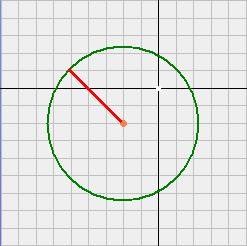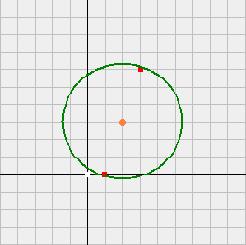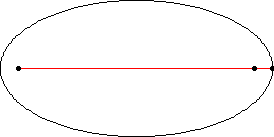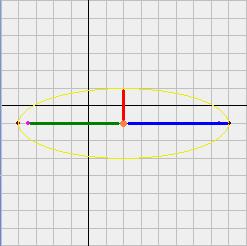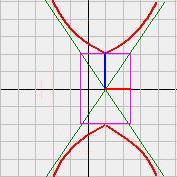Go to Long Test II
| Part 1: Quadratic Equations in one variable | Quadratic Equations deal with polynomials written with variables in the 2nd degree. Because the
variables are in the 2nd degree, we expect two answers (or roots) for every equation. The
standard form for quadratic equations is: Ax2 + Bx + C = 0 In this arrangement A ≠ 0 because if A = 0 then the polynomial is not in the 2nd degree and we would have only a linear equation. Balik nnman first term. The ways of solving quadratic equations are listed below: |
| Zero-factor property | Basically solve by factoring. The key assumption here is that if ab = 0, then either a or b = 0.
Oonga naman, kung multiply mo sa 0 kaht anong no. ay 0 ang sagot mo so either a or b is zero. That's
why we can equate each factor of the quadratic expression to 0. So if we factor the expression Ax + By + C = 0 makukuha natin ung (ox+p)(qx+r) where o, p q and r are real nos. Next step is to equate both to zero. ox + p = 0 and qx + r = 0 Our two answers are: x = -p/o and x = -r/q Nakuha ang sagot na yan by transposing the p and the r. Then, to remove the coefficient of x we divide by o or q respectively. Wag kalimutan isulat ang solution set. |
| Square-root property i | There are two square-root property possibilities. Eto ung una. This is a quick way of finding the
value of x, if and only if the quadratic equation is in the form x2 = k The solution is x = ±√k may ± dahil pag ni-square ang negative no. lalabas ay positive parin. Note that if k is a negative number, there is no real solution to the equation. |
| Square-root property ii | Second square root property. The quadratic equation is written in the form m(px + q)2 = r Ang solution dito first divide r/m to get rid of m on the left, then get the square root. √(px + q)2 = ±√r/m the left becomes simply px + q and the right, resolve it. tapos use algebra to isolate x, to get the values. |
| Completing the square | This method also uses factoring as the main solution. First write the quadratic equation in the form (x2 + Bx + C = 0). Then take the value of B and divide by 2. Then square the quotient. The value of the squared quotient is the value that your C is supposed to be in order to complete the square. Add it to both sides of the equation Once you have the perfect square trinomial you can factor it out. Use the factoring tools such as difference of 2 squares, sum of 2 squares, etc. |
| Quadratic Formula | This method is longer than the other special methods, but it is a sure way to find the value of the
variable in any quadratic equation. It will work with all quadratic equations. First write the equation in standard form. Then use the formula: 2a |
| Part 2: More on Quadratic Equations | Dito isiningit ang special lessons.. more on the discriminant value here, how it relates to the roots of an equation, and the sum and product of the roots. | ||||||||||
| Discriminant value and type of roots | Depending on the discriminant value that you get, you will be able to determine the kind of roots
the quadratic equation will have. Refer to the table. the discriminant is equal to b2 -4ac
|
||||||||||
| Sum and product of roots | The sum of the two roots of an equation is given by the expression negative b over a. In this case,
a is the coefficient of the square of x, tapos b is the coefficient of the non-squared x. The product of the roots is given by the expression c over a. Use a as above, while c is the constant at the end of the quadratic equation (in standard form). Mahahanap ang roots, or the equations themselves using these two expressions. If given the exact root values, you can add them and multiply them, tapos equate to the c/a or -b/a to get the standard form of the quadratic equation. If given the standard form, you can divide by a, get the negative of b/a to get the sum of the roots. Same with the product, use c/a. |
| Part 3: Conic Sections | *Intersection of a plane with two right vertical cones. Given by a quadratic equation
in two variables. General form is in: Ax2 + By2 + Cy Intersections take on 4 shapes. |
||||||||||||||||||
| Introduction | Laking pasalamat ko sa first Math project for the term kase hindi ko na kailangan idrawing ung
conic sections (sa paint! argh!).. more or less napi-picture na ang itsura ng conics dahil dun. So conic sections show intersections. since the plane extends infinitely, nagkakaroon minsan ng plane that intersects the cones twice. Yun ung hyperbola. as for the other three, kahit na gaanong kalayo mo iextend ung planes, hanggang dun lang sila magi-intersect with the plane. the three other shapes are the ellipse, circle and parabola. The altitude runs in the center of the cones, it is an imaginary vertical line. |
||||||||||||||||||
| Ellipse | Diagonal intersection of a plane with the cones. | ||||||||||||||||||
| Circle | Special occurence of an ellipse. Occurs when the plane intersects with the cones horizontally. Plane is perpendicular with the altitude of the cones | ||||||||||||||||||
| Parabola | Song ng Tool. De joke lang, pero may song tlga ang tool na parabola. Sa math naman, this is the Intersection of the plane with the edge of the cones. Makes a sort of curved shape | ||||||||||||||||||
| Hyperbola | Vertical intersection of a plane with the cones. Parallel with the altitude of the cones. | ||||||||||||||||||
| How to tell w/c conic from the gen. form | This next table shows the conditions of a certain conic given its general form. Para malaman mo na
agad what kind of conic pala tlga un. It was given nung lt2, medyo nakakagulo din.
|
||||||||||||||||||
| Part 4: PARABOLA | The parabola. ung unang conic na tinalakay in detail. it's a curve. many practical applications in real life. | ||||||||||||||||||||||||||||||||||||||||||||||||
| Definitions | Set of all points equidistant from a fixed point (called the focus) and a line below its vertex
called the directrix. There are 4 possible orientations of a parabola: up, down, left and right
|
||||||||||||||||||||||||||||||||||||||||||||||||





